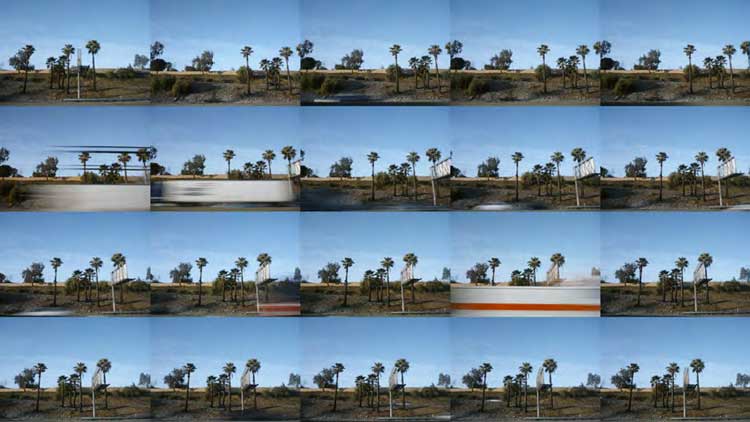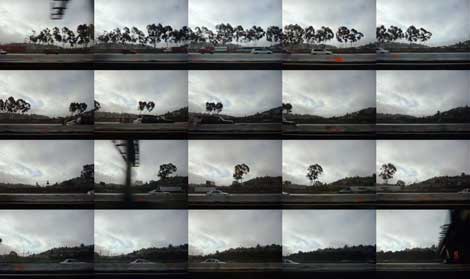When I was just out of school and began my first regular daily commute of the Southern California freeways, I remember stealing glances to either side of the road. I caught brief glimpses of the fleeting vistas, noting how with every quarter mile, my vantage point changed. On an extended road trip up through the Northwest and across the northern plains, I began taking pictures from the car. After a brief sojourn in the Midwest, I swept through the Southwest on my way back to Southern California, again, taking photos from my moving vehicle. I was never systematic about it; I simply shot things that caught my attention. When I returned to California, I bought an auto-winder for my already obsolete manual SLR so I could shoot faster. I was enchanted with the shapes of the surrounding hills and the trails carved by cattle into the hollows and steep inclines of Brea Canyon. I fantasized about putting an image of an open road, based on a photo I had taken in rural Washington, up on a billboard next to the 210 Freeway near Irwindale. I imagined that frustrated drivers would see it as they crept through rush hour. They would be either irritated by the unattainable simplicity of it or enter it visually as a meditative release to the dulling grind of traffic. Yet, as enamored as I was with the visual experience of movement—the changing curve of an overpass, the interaction of geometric shapes between the ramps and arcs of freeway interchanges, the mountains ringing the Los Angeles basin and the union of sky, soil and concrete—I continued to think of my perceptions as isolated moments that could be conveyed in terms of singular iconic images.
In hindsight, it doesn’t seem like much of a leap: abandoning the search for the singular image in favor of a sequential visual experience. After all, it is just an arrested version of what we see in films: the repeating frame. Robbert Flick made the leap after completing his “Arena” series (1977–1979) depicting a parking garage in formal black-and-white stills. His subsequent work conveys a fragmented sense of moving through Los Angeles in contact sheet-like photographs.
“Freeways,” Flick’s solo show currently at Rose Gallery through April 12, provided the setting for a conversation this past Sunday, March 30, between the veteran LA artist and his interlocutor, author and Los Angeles Times book critic, David Ulin. The Los Angeles Review of Books, which celebrates its three-year anniversary on April 19, put on the event as a part of the publication’s ongoing series of conversations between artists and critics. Introducing Flick, Ulin referenced their mutual interest in making an “art of the mundane” in a city where “daily activities like going to work tend to be overlooked in favor of mythic tropes,” adding that Flick’s interest in repetition or “retinal increments” resonates with the way that most people experience the city.
Flick’s freeway photographs, generated from thousands of still images the artist took during his commute from his home in Claremont to USC where he is on the faculty, cover much of the same territory I drove on my way to Bergamot Station to hear Ulin and Flick’s dialogue.
The freeway generates its own rhythm. It is far too easy to drift into a semi-trance-like state, realizing after a few miles that one has been driving by autopilot. This lack of focus, or, rather, focus on the destination while losing site of the journey, was indirectly the subject of discussion. Flick repeatedly underscored his interest in drawing attention to what is between the frames, and to “empathically respond to whatever is there.” He waxed poetic at times, describing how his morning walks provide unexpected sensual experience—taking in the aroma of someone’s shampoo from an open window, for example—that he would never notice if he were focused on a preconceived outcome.
Significantly, in titling his work with a series of numbers, suggesting a cool, rational nomenclature rather than a poetic, symbolic or narrative name, Flick signals a matter-of-fact empiricism. Visually, the cool nature of the observer comes through in the data-rich images. Yet, Flick’s work becomes ambidextrous at this point. His interest in observing experiences of the city that are regularly overlooked or elided seems consistent and at the same time at odds with his process. Whereas his collection of massive amounts of data and apprehension of the city through sensual experience speaks to an empirical evaluation of the city, Flick’s interest in responding empathically moves his practice into the realm of the subject and an interior world that coexists with that of the critical observer.
Ulin and Flick overemphasized the randomness of image collection in Flick’s practice, for he is very intentional about where he operates his camera and the rational for sites. He is also intentional when it comes to selecting which still frames, out of thousands, coalesce into a discernible narrative. And this is where subjectivity further enters the process. It is not a random selection process, nor is it statistically based, but it is predicated on Flick’s sensitivity as a photographer and an artist. As Flick stated in conversation, his photographs are fictitious. Flick compared the process of making his photographs to the process of writing and editing repeatedly, to arrive at a final narrative in much the same way Dylan Thomas wrote 30 possible word choices to end up with one.
Flick’s interest in investigating the minutiae of the city and creating a visual equivalent to sensual experience, whether it is the bounce of the train at a predictable location or reflected light illuminating the freeway—all stimuli Flick mentioned in his discussion of working and experiencing the city—does not result in a sequence of random images, nor is that the way we perceive our experience. It accounts for a certain amount of randomness, but the reality is that Flick is creating an authorial narrative.
ALL IMAGES COURTESY ROSE GALLERY
ROBBERT FLICK IMAGES: Archival Pigment Print, Signed in ink by the artists on signature label adhered to mount verso, Number one in a limited edition of five, From the collection of the artist
Robbert Flick: “Freeways” at RoseGallery. Ends April 12, 2014
At Bergamot Station Arts Center; for info: rosegallery.net





